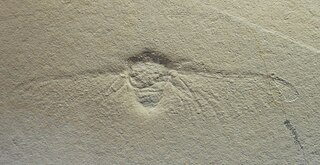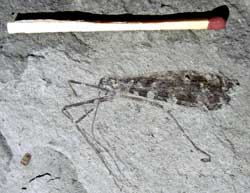
Bittacidae is a family of scorpionflies commonly called hangingflies or hanging scorpionflies.

Eomeropidae is a family of aberrant, flattened scorpionflies represented today by only a single living species, Notiothauma reedi, known from the Nothofagus forests in southern Chile, while all other recognized genera in the family are known only as fossils, with the earliest definitive fossil known from Liassic-aged strata, and the youngest from Paleogene-aged strata.
Ororaphidia is an extinct genus of snakefly containing two species: the type species Ororaphidia megalocephala and Ororaphidia bifurcata.

Styporaphidia is a genus of snakefly, belonging to the extinct family Mesoraphidiidae, containing up to two species, the type species Styporaphidia magia and tentatively Styporaphidia? hispanica. The genus was named from the Greek stypos meaning "stem" or "stump" and Raphidia, the type genus for, and most often used as, a stem for generic names in the order Raphidioptera. The species name of S. magia is from the Greek word mageia meaning "magic" while the species name for S.? hispanica is from the Latin Hispania meaning "Spain" in reference to the type locality of the species.

The Haifanggou Formation is a fossil-bearing rock deposit located near Daohugou village of Ningcheng County, in Inner Mongolia, northeastern China.
Eolepidopterigoidea is an extinct superfamily of moths, containing the single family Eolepidopterigidae, although the genus Undopterix is sometimes placed in a separate family Undopterigidae. The type-genus of the family is Eolepidopterix.

Mongolarachne is an extinct genus of spiders placed in the monogeneric family Mongolarachnidae. The genus contains only one species, Mongolarachne jurassica, described in 2013, which is presently the largest fossilized spider on record. The type species was originally described as Nephila jurassica and placed in the living genus Nephila which contains the golden silk orb-weavers.

Palaeontinidae, commonly known as giant cicadas, is an extinct family of cicadomorphs. They existed during the Mesozoic era of Europe, Asia, and South America. The family contains around 30 to 40 genera and around a hundred species.
Sinomeganeura is an extinct genus of griffenfly in the family Meganeuridae and containing a single species Sinomeganeura huangheensis. The species is known only from Late Carboniferous, Namurian stage, Tupo Formation near the village of Xiaheyan in Ningxia Hui Autonomous Region, China.
Bohemiatupus is an extinct genus of griffenfly in the family Meganeuridae and containing a single species Bohemiatupus elegans. The species is known only from the Late Carboniferous, Bolsovian stage, Kladno Formation near the village of Radnice in the Radnice Basin, Czech Republic.
Mongolbittacus is an extinct genus of hangingfly in the family Bittacidae and containing a single species Mongolbittacus daohugoensis. The species is known only from the Middle Jurassic Jiulongshan Formation, part of the Daohugou Beds, near the village of Daohugou in Ningcheng County, northeastern China.
Formosibittacus is an extinct genus of hangingfly in the family Bittacidae and containing a single species Formosibittacus macularis. The species is known only from the Middle Jurassic Jiulongshan Formation, part of the Daohugou Beds, near the village of Daohugou in Ningcheng County, northeastern China.

Omma is a genus of beetles in the family Ommatidae. Omma is an example of a living fossil. The oldest species known, O. liassicum, lived during the final stage of the Triassic (Rhaetian), over 200 million years ago. Numerous other fossil species are known from the Jurassic and Cretaceous of Europe and Asia. The only living species is Omma stanleyi, which is endemic to Australia. Three other extant species that were formerly part of this genus were moved to the separate genus Beutelius in 2020.Omma stanleyi is strongly associated with wood, being found under Eucalyptus bark and exhibiting thanatosis when disturbed. Its larval stage and many other life details are unknown due to its rarity. Males are typically 14-20 mm in length, while females are 14.4-27.5 mm. Omma stanleyi occurs throughout eastern Australia from Victoria to Central Queensland.

Juracimbrophlebia is an extinct genus of hangingflies that lived during the Middle Jurassic Period about 165 million years ago, containing only its type species, Juracimbrophlebia ginkgofolia; it was discovered in deposits from Daohugou in northeastern China’s Inner Mongolia.

Miriholcorpa is an extinct genus of scorpionfly (Mecoptera) from the Middle Jurassic period of China. The type and only species is M. forcipata, described in 2013.

Chresmodidae is an extinct family of Mesozoic insects within the superorder Polyneoptera.

Jurassipanorpa is a genus of fossil scorpionfly containing two species described in 2014 from the Jiulongshan Formation of Inner Mongolia, China. The two species, J. impuctata and J. sticta, lived in the late Middle Jurassic period and represent the oldest known representatives of the scorpionfly family Panorpidae.
Holcorpa is a genus of extinct insects in the scorpionfly order Mecoptera. Two Eocene age species found in Western North America were placed into the genus, H. dillhoffi and H. maculosa.

Cimbrophlebiidae is an extinct family of scorpionflies. They are considered to be the sister group to the Bittacidae, together forming the clade Raptipedia.

Archisargidae is an extinct family of brachyceran flies known from the Jurassic and Cretaceous periods. It is part of the extinct superfamily Archisargoidea. Most members of the family are known from the Callovian-Oxfordian Daohugou biota of Inner Mongolia, China, and the equivalently aged Karabastau Formation of Kazakhstan. The family has been found to be paraphyletic with respect to Eremochaetidae in a cladistic analysis.












